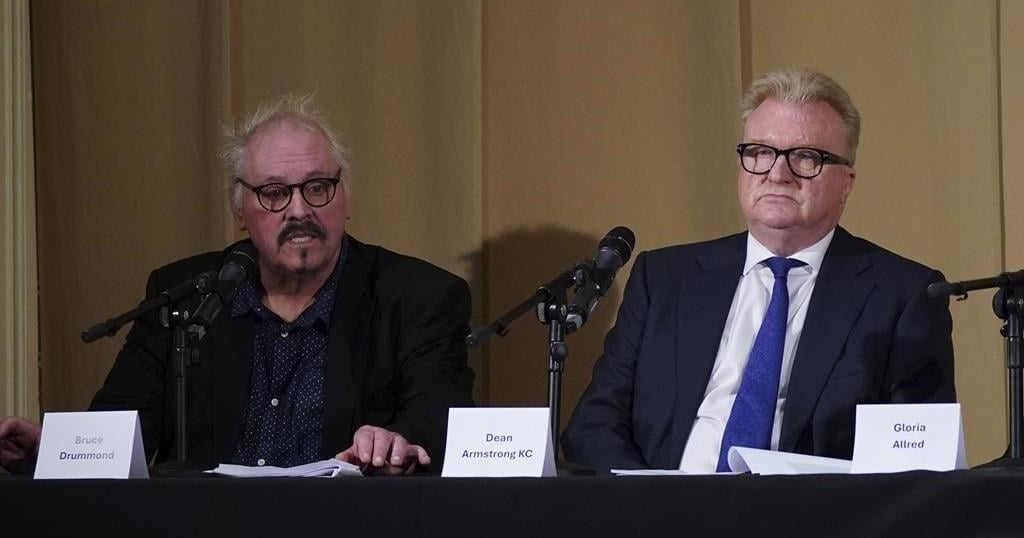LONDON (AP) — Lawyers in Britain representing dozens of alleged victims of Mohamed Al Fayed, the former boss of Harrods, said Friday their clients assert that he was a “monster” who raped and sexually abused young women.
The abuse went on through much of Al Fayed’s 25-year tenure — from 1985 on — at the helm of the world-renowned London department store, the lawyers said. They spoke at a televised news conference in London in the wake of the BBC documentary “Al-Fayed: Predator At Harrods.”
The four-member legal team told reporters they have been retained by 37 of Al Fayed’s accusers and were in the process of adding more clients, including potentially from other organizations that Al Fayed was involved with.
In the documentary, which was broadcast on Thursday, the Egypt-born Al Fayed who died last year at the age of 94, was accused of raping at least five women at his properties in London and Paris and of committing scores of other acts of assault and physical violence, both in and outside of Harrods.
“We will say it plainly, Mohamed Al Fayed was a monster,” said lead lawyer Dean Armstrong. “But he was a monster enabled by a system, a system that pervaded Harrods.”
Armstrong said the case combined “some of the most horrific elements” of cases such as those involving Jimmy Savile, Jeffrey Epstein and Harvey Weinstein — well-known and powerful men who were able to avoid sexual abuse allegations for years before their victims finally came forward.
Some of Al Fayed’s accusers were teenagers at the time of the abuse, with at least one as young as 15, according to the BBC documentary.
London’s Metropolitan Police have said they were made aware of allegations in the past and had questioned Al Fayed in 2008 in connection with the sexual abuse of a 15-year-old but prosecutors at the time did not take the cases forward.
There was also no comment from Al Fayed’s family.
One of Al Fayed’s alleged victims spoke at the news conference. She was identified only as Natacha and said the billionaire businessman was “highly manipulative” and “preyed on the most vulnerable, those of us who needed to pay the rent and some of us who didn’t have parents to protect them.”
Natacha, who said she joined Al Fayed’s team of personal assistants at the age of 19, recounted being invited to his private apartment one night “on the pretext of a job review.” When she arrived, she said she saw the bedroom door partially open with sex toys in view.
“I felt petrified. I perched myself at the very end of the sofa and then … Mohamed Al Fayed, my boss, the person I worked for, pushed himself onto me,” she said.
After kicking herself free, she said Al Fayed threatened her.
“He laughed at me,” she said. “He then composed himself and he told me, in no uncertain terms, that I was never to breathe a word of this to anyone and that if I did, I would never work in London again and he knew where my family lived.”
“I felt scared and sick,” she added.
In the United Kingdom, victims often identify themselves by only one name to protect their privacy. It wasn’t clear why Natacha gave only one name while appearing before cameras, or if that was her real first name.
The Associated Press does not identify victims of sexually assault unless they have come forward and voluntarily identified themselves. The team of lawyers could not immediately be reached for comment.
Al Fayed moved to Britain in the 1960s, after early investments in shipping in Italy and the Middle East, and started building an empire.
At the height of his wealth, he owned the Ritz hotel in Paris and the southwest London soccer team Fulham. He moved in high circles in London but was never knighted. He became a prominent conspiracy theorist after the Paris crash that killed his son Dodi and Princess Diana in 1997.
Al Fayed sold Harrods in 2010 to a company owned by the state of Qatar via its sovereign wealth fund, the Qatar Investment Authority.
In a statement to the BBC, the Harrods owners said they were “utterly appalled” by the allegations of abuse but added that they were only made aware of them last year.
“While we cannot undo the past, we have been determined to do the right thing as an organization, driven by the values we hold today, while ensuring that such behavior can never be repeated in the future,” the owners said in a statement.
Armstrong dismissed Harrods’ claim that the owners knew nothing of the sexual allegations made against Al Fayed over many years, citing several media reports in recent years over allegations of sexual misconduct on the part of Al Fayed. The BBC documentary said at least one alleged victim had signed a non-disclosure agreement.
“We are here to say publicly and to the world, or to Harrods in front of the world, that it is time that they took responsibility,” Armstrong said. “That is something they should do as soon as possible.”
U.S. lawyer Gloria Allred, who has represented victims in some of the most notorious sexual abuse cases in recent years, including those about abuse by Epstein, Weinstein and Bill Cosby, also spoke and lambasted the culture at Harrods during Al Fayed’s tenure.
“Harrods is often referred to as the most beautiful store in the world … many women dreamed of working there,” she said. “However, underneath the Harrods glitz and glamour was a toxic, unsafe and abusive environment.”
